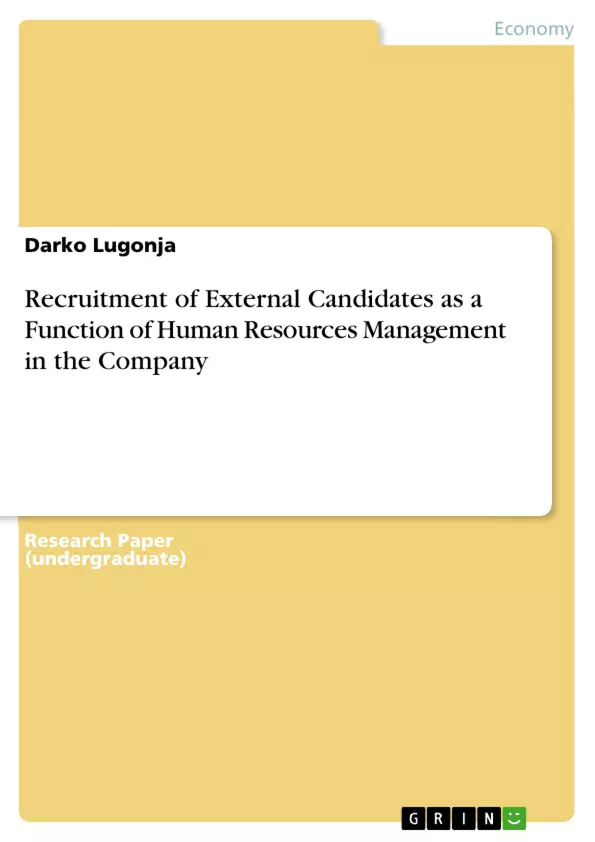Modern business policy is based upon successful management of resources, especially human resources. Employment and recruitment are becoming human resource basic functions. Companies and organizations must consider again their own business policy and goals, in order to define and realize optimal business policy, particularly human resources recruitment. Recruitment of internal candidates is almost a rule for solving the problem of shortage in certain profile of employees. Yet, mostly, in the situation of insufficient human resources, we focus our attention to external candidates, through cooperation with media, educational institutions, agencies and other communication approaches. Media have emphasized role. Advertising on the Internet, newspapers and TV depends on many variables. Besides cost aspect there is significance in communication aspect, an rising attention onto target group from which we plan to recruit our candidates. Therefore, media role is growing in importance, not only in sales, public relations or promotion, but also in employment, actually, in recruitment of human resources from external sources. Choice of an appropriate media and an adequate message in advertising are becoming more important for the communication effects of employment process, as well as advertising itself. In the Internet domination era and development of new communication approches (social networks and Internet forums), individuals and organizations are focusing their attention to this media and its potential. Growing number of opportunities and target markets' new value system are recognizable through growing number of Internet sites, portals, but also in the Internet browser influence (Google, Yahoo, Bing…). Campaigns for recruitment of new employees through open employment tender invitations on Internet sites of all sorts of companies and organizations are part of this new approach to human resources. Systematic approach, opennes to new opportunities and media, development and focus onto new potentials and resources are part of postulates for business survival.
Inhaltsverzeichnis (Table of Contents)
- Introduction
- New corporate goals
- Fulfilment of customers' needs
- Productivity and profit
- Employees contentment
- Human resource functions
- PLANNING
- RECRUITMENT
- SELECTION
- PLACEMENT
- INTRODUCTION TO EMPLOYMENT
- SALARIES AND BENEFITS
- PROFESSIONAL DEVELOPMENT
- HUMAN RELATIONS
- EDUCATION
- PROMOTIONS
- EFFICIENCY EVALUATION
- RETIREMENT PREPARATIONS
- INFORMING
- Literature on recruitment and selection of candidates
- Segment of recruitment and selection of employees among human resources functions
- Case study „KRAŠ“ d.d., Zagreb
- Recruitment of candidates
- Recruitment of internal candidates
- Recruitment of external candidates
- Media
- Employment institute
- Private agencies
- Educational institutions
- Postal informing
- Special occasions
- Conclusion
- Literature
Zielsetzung und Themenschwerpunkte (Objectives and Key Themes)
This scientific work aims to provide a comprehensive overview of employee recruitment in companies and organizations, focusing on contemporary human resource management and development. It also aims to establish a model for further development of other models, with the support of documentary, business, and scientific materials, as well as data from Croatian and international companies. The work examines the case study of “Kraš” d.d., Zagreb in 1994, highlighting the effectiveness of its human resource policy in the long term.
- Recruitment as a Key Function in Human Resource Management
- External Recruitment: Utilizing Media, Agencies, and Educational Institutions
- The Impact of Changing Business Conditions on Human Resource Strategy
- The Importance of Successful Human Resource Policy in Achieving Business Goals
- The Role of Media in Modern Recruitment Practices
Zusammenfassung der Kapitel (Chapter Summaries)
The introduction sets the stage for the work, outlining its purpose and methodology. The chapter on new corporate goals explores the impact of evolving business conditions on company strategies and the need for a successful human resource policy. It also delves into the key objectives of modern companies, emphasizing customer satisfaction, productivity, and employee contentment.
The subsequent chapter dissects the functions of human resource management and development, highlighting the key steps in the recruitment process. These include planning, advertising, selection, placement, onboarding, salary and benefits, professional development, human relations, education, promotions, efficiency evaluation, retirement preparations, and communication.
The case study on “Kraš” d.d., Zagreb provides a real-world example of successful human resource policy, illustrating the recruitment of quality control engineers in 1994. This chapter explores the company's strategies for attracting and retaining talent, including internal and external recruitment methods. It also delves into the company's use of various media platforms for recruitment and the challenges they faced due to data protection and privacy concerns.
Schlüsselwörter (Keywords)
Human resource management, recruitment, external candidates, business policy, media, advertising, internet, employee satisfaction, organizational culture, case study, Kraš d.d., Zagreb.
- Citation du texte
- Darko Lugonja (Auteur), 2009, Recruitment of External Candidates as a Function of Human Resources Management in the Company, Munich, GRIN Verlag, https://www.grin.com/document/172503



